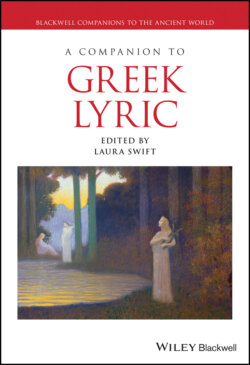Читать книгу A Companion to Greek Lyric - Группа авторов - Страница 79
Marginal Notes, Sigla, and Corrections
ОглавлениеIn addition to the text itself, lyric papyri occasionally contain additional material of practical and exegetical value: critical symbols such as the paragraphus or the diplē; punctuation; diacritical signs (i.e., breathings, accents); marginalia (including corrections or annotations); and metrical, stichometrical, or colometrical marks (Figure 7.11). Some are the work of the original scribe, while others were added later by one or more users. Accents assist in reading, scansion, as well as the analysis of dialect (as in P.Fouad inv. 239, above; see further, Dialect and Meter, below). Critical symbols, by contrast, tend to mark a division of one sort or another: in lyric papyri one finds especially the asterisk (※), paragraphus ( ⸏ ) coronis (⸎, essentially a paragraphus with decorative curlicue), and diplē obelismenē (˒–, or “forked paragraphus”) (Figure 7.12). The coronis and asterisk most commonly mark the end of a poem, but can do so in conjunction both with one another and with other symbols, which are predominately used for metrical divisions (i.e., distinguishing stanzas or triads). Other sigla can indicate textual variants, omissions, or marginal notes, though their purpose is sometimes opaque.
Figure 7.11 P.Köln 2.59 (= Alcaeus fr. 298), with accents as well as long and short quantities marked. (© Institut für Altertumskunde an der Universität zu Köln. Used under Creative Commons Attribution 4.0 International License.)
Figure 7.12 P.Oxy. 26.2441 (= Pindar, Paeans 14-15 S-M), with accents, marginal comments, coronis, and asterisk. (Courtesy of The Egypt Exploration Society and the University of Oxford Imaging Papyri Project.)
Sometimes practical aids have exegetical value, too. Thanks to the stichometrical indicator ΧΗΗΗΔΔ in the colophon of one fragment of P.Oxy. 10.1231 (Figure 7.13), we know that the first book of the Alexandrian edition of Sappho contained 1,320 verses (= 330 Sapphic stanzas); the numeral Ν (= 13) in the margin of P.Oxy. 33.2617 similarly marks the 1,300th line of Stesichorus’ Geryoneis, a scale of narrative that confirms the ancient attribution of multi-volume works to his oeuvre (see Finglass, this volume). Other marginalia are significant for providing a glimpse of ancient scholarship (Figure 7.14). Such research was originally produced as independent hypomnemata (= commentaries), but was subsequently incorporated into texts by users in the form of notes. Sometimes, as was previously mentioned, textual variants or omissions are marked, but twenty-first-century students of lyric will appreciate that there were aspects of the poetry which required commentary and exegesis in antiquity, as well—especially technical matters (e.g., dialect, meter) and interpretive ones (e.g., historical context). All such ancient scholarship preserved on papyrus is now in the process of being collected in the multi-volume Commentaria et lexica Graeca in papyris reperta (= CLGP). To date, the scholarship on Alcaeus, Alcman, Anacreon, and Bacchylides has been published; that on Pindar, Simonides, Stesichorus, and lyric adespota is expected in future volumes.
Figure 7.13 P.Oxy. 10.1231, fr. 56 (= Sappho fr. 30), now in the Bodleian Library MS. Gr. Class. c. 76. This fragment preserves the final column of the first book of the Alexandrian edition of Sappho, with coronis and stichometrical colophon. (Courtesy of The Bodleian Libraries, The University of Oxford.)
